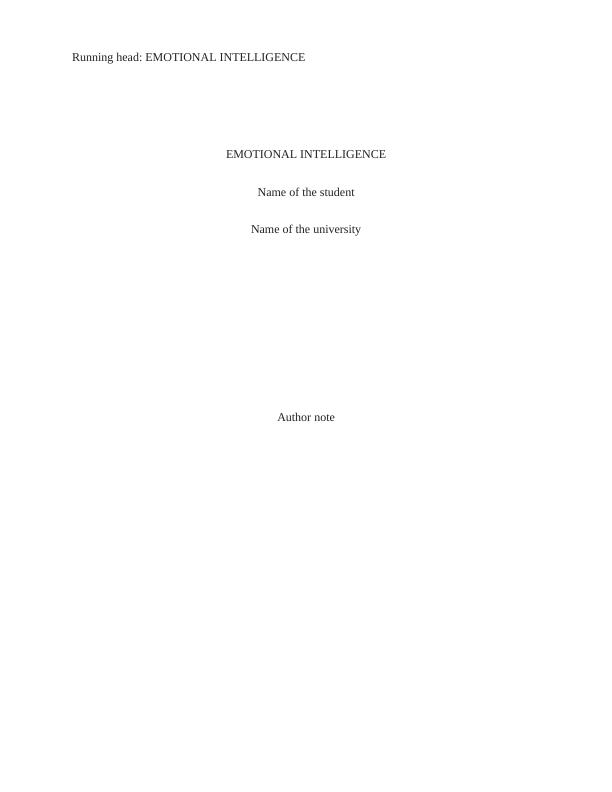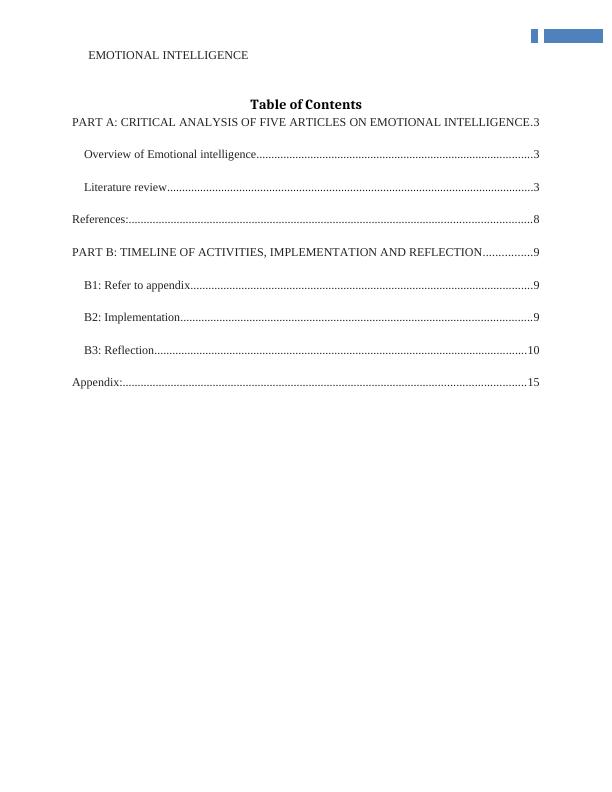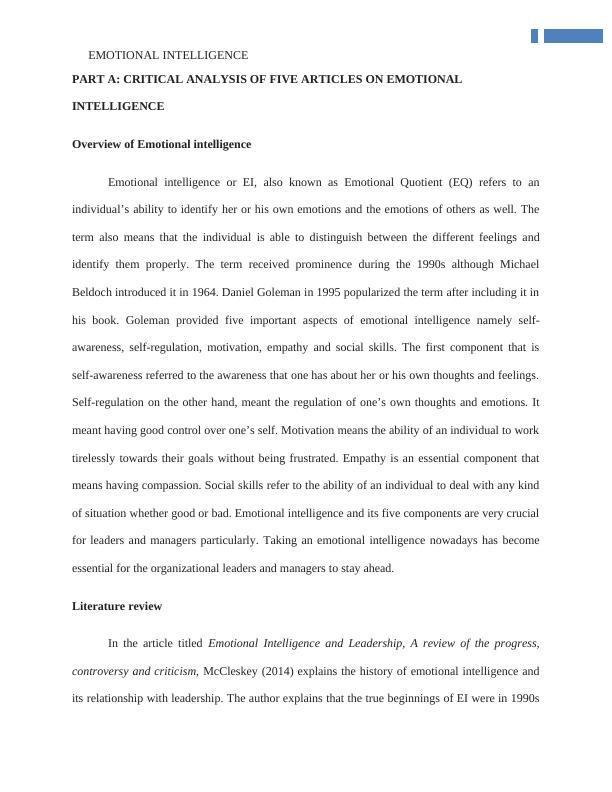Emotional Intelligence: Critical Analysis of Five Articles
Added on 2023-03-20
18 Pages4049 Words30 Views
Running head: EMOTIONAL INTELLIGENCE
EMOTIONAL INTELLIGENCE
Name of the student
Name of the university
Author note
EMOTIONAL INTELLIGENCE
Name of the student
Name of the university
Author note

1
EMOTIONAL INTELLIGENCE
Table of Contents
PART A: CRITICAL ANALYSIS OF FIVE ARTICLES ON EMOTIONAL INTELLIGENCE.3
Overview of Emotional intelligence............................................................................................3
Literature review..........................................................................................................................3
References:......................................................................................................................................8
PART B: TIMELINE OF ACTIVITIES, IMPLEMENTATION AND REFLECTION................9
B1: Refer to appendix..................................................................................................................9
B2: Implementation.....................................................................................................................9
B3: Reflection............................................................................................................................10
Appendix:......................................................................................................................................15
EMOTIONAL INTELLIGENCE
Table of Contents
PART A: CRITICAL ANALYSIS OF FIVE ARTICLES ON EMOTIONAL INTELLIGENCE.3
Overview of Emotional intelligence............................................................................................3
Literature review..........................................................................................................................3
References:......................................................................................................................................8
PART B: TIMELINE OF ACTIVITIES, IMPLEMENTATION AND REFLECTION................9
B1: Refer to appendix..................................................................................................................9
B2: Implementation.....................................................................................................................9
B3: Reflection............................................................................................................................10
Appendix:......................................................................................................................................15

2
EMOTIONAL INTELLIGENCE
PART A: CRITICAL ANALYSIS OF FIVE ARTICLES ON EMOTIONAL
INTELLIGENCE
Overview of Emotional intelligence
Emotional intelligence or EI, also known as Emotional Quotient (EQ) refers to an
individual’s ability to identify her or his own emotions and the emotions of others as well. The
term also means that the individual is able to distinguish between the different feelings and
identify them properly. The term received prominence during the 1990s although Michael
Beldoch introduced it in 1964. Daniel Goleman in 1995 popularized the term after including it in
his book. Goleman provided five important aspects of emotional intelligence namely self-
awareness, self-regulation, motivation, empathy and social skills. The first component that is
self-awareness referred to the awareness that one has about her or his own thoughts and feelings.
Self-regulation on the other hand, meant the regulation of one’s own thoughts and emotions. It
meant having good control over one’s self. Motivation means the ability of an individual to work
tirelessly towards their goals without being frustrated. Empathy is an essential component that
means having compassion. Social skills refer to the ability of an individual to deal with any kind
of situation whether good or bad. Emotional intelligence and its five components are very crucial
for leaders and managers particularly. Taking an emotional intelligence nowadays has become
essential for the organizational leaders and managers to stay ahead.
Literature review
In the article titled Emotional Intelligence and Leadership, A review of the progress,
controversy and criticism, McCleskey (2014) explains the history of emotional intelligence and
its relationship with leadership. The author explains that the true beginnings of EI were in 1990s
EMOTIONAL INTELLIGENCE
PART A: CRITICAL ANALYSIS OF FIVE ARTICLES ON EMOTIONAL
INTELLIGENCE
Overview of Emotional intelligence
Emotional intelligence or EI, also known as Emotional Quotient (EQ) refers to an
individual’s ability to identify her or his own emotions and the emotions of others as well. The
term also means that the individual is able to distinguish between the different feelings and
identify them properly. The term received prominence during the 1990s although Michael
Beldoch introduced it in 1964. Daniel Goleman in 1995 popularized the term after including it in
his book. Goleman provided five important aspects of emotional intelligence namely self-
awareness, self-regulation, motivation, empathy and social skills. The first component that is
self-awareness referred to the awareness that one has about her or his own thoughts and feelings.
Self-regulation on the other hand, meant the regulation of one’s own thoughts and emotions. It
meant having good control over one’s self. Motivation means the ability of an individual to work
tirelessly towards their goals without being frustrated. Empathy is an essential component that
means having compassion. Social skills refer to the ability of an individual to deal with any kind
of situation whether good or bad. Emotional intelligence and its five components are very crucial
for leaders and managers particularly. Taking an emotional intelligence nowadays has become
essential for the organizational leaders and managers to stay ahead.
Literature review
In the article titled Emotional Intelligence and Leadership, A review of the progress,
controversy and criticism, McCleskey (2014) explains the history of emotional intelligence and
its relationship with leadership. The author explains that the true beginnings of EI were in 1990s

3
EMOTIONAL INTELLIGENCE
when Salovey and Mayer presented an EI framework. Goleman who reproduced the work of
these two authors popularized the concept then. The author sheds light on the various models of
EI that developed over time and became popular amongst leaders and managers. He follows a
systematic pattern where he first introduces the concept and then uses the literature to provide
different definitions of the term. The author then delves into discussing the various models of EI.
He discusses the ability models, the mxed modles, trait models and other such models of EI.
Apart from discussing the models, the author also discusses the various tests of EI that could be
found in the broad literature. The different tests that he discusses include the Mayer-Salovey-
Caruso Emotional Intelligence Test (MSCEIT) and the Workgroup Emotional Intelligence
Profile (WEIP). Both the two tests are popular amongst managers and leaders of organizations.
However, the author does not provide any new dimension to the definition. In contrast to this,
authors Carson, Carson and Birkenmeier (2016) stress on the validation of the instruments used
to measure emotional intelligence.. According to the authors, there is no instruments as validated
for measuring emotional intelligence present in the academic literature for trainers, management
consultants and business practitioners to use while surveying employees’ views on their
emotional intelligence. Hence, the authors created and scrutinized a new measure for EI that was
trimmed to 30 minutes with reduced items of testing. The authors described emotional
intelligence as the concept that has come of age to be touted as the construct that assists
organizations in reducing employee turnover. In addition to that, the authors also state that EI
helps organizations in identifying the transformational leaders, aiding in executive coaching,
producing more efficient work teams and so on. Although emotional intelligence has received
wide publicity, it frustratingly lacks validity and “non-proprietary measure of emotional
intelligence in the public domain”. However, the article does not clearly state the names of the
EMOTIONAL INTELLIGENCE
when Salovey and Mayer presented an EI framework. Goleman who reproduced the work of
these two authors popularized the concept then. The author sheds light on the various models of
EI that developed over time and became popular amongst leaders and managers. He follows a
systematic pattern where he first introduces the concept and then uses the literature to provide
different definitions of the term. The author then delves into discussing the various models of EI.
He discusses the ability models, the mxed modles, trait models and other such models of EI.
Apart from discussing the models, the author also discusses the various tests of EI that could be
found in the broad literature. The different tests that he discusses include the Mayer-Salovey-
Caruso Emotional Intelligence Test (MSCEIT) and the Workgroup Emotional Intelligence
Profile (WEIP). Both the two tests are popular amongst managers and leaders of organizations.
However, the author does not provide any new dimension to the definition. In contrast to this,
authors Carson, Carson and Birkenmeier (2016) stress on the validation of the instruments used
to measure emotional intelligence.. According to the authors, there is no instruments as validated
for measuring emotional intelligence present in the academic literature for trainers, management
consultants and business practitioners to use while surveying employees’ views on their
emotional intelligence. Hence, the authors created and scrutinized a new measure for EI that was
trimmed to 30 minutes with reduced items of testing. The authors described emotional
intelligence as the concept that has come of age to be touted as the construct that assists
organizations in reducing employee turnover. In addition to that, the authors also state that EI
helps organizations in identifying the transformational leaders, aiding in executive coaching,
producing more efficient work teams and so on. Although emotional intelligence has received
wide publicity, it frustratingly lacks validity and “non-proprietary measure of emotional
intelligence in the public domain”. However, the article does not clearly state the names of the

End of preview
Want to access all the pages? Upload your documents or become a member.
Related Documents
Developing Emotional Intelligence - A Professional Workshop Planlg...
|12
|3109
|83
Emotional Intelligencelg...
|8
|1750
|481
Developing Emotional Intelligence Skills for the Workplacelg...
|21
|5147
|231
Organizational Design Fundamentals and Emotional Intelligence in Contemporary Organizationslg...
|6
|1528
|233
Emotional Intelligence - PDFlg...
|9
|2381
|464
Emotional Intelligence and Cultural Diversitylg...
|8
|2023
|327
